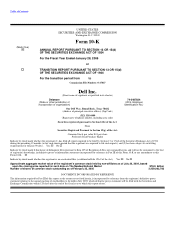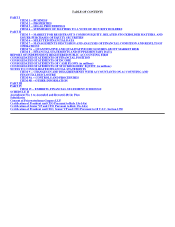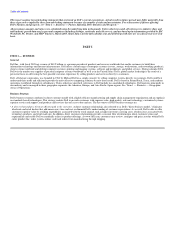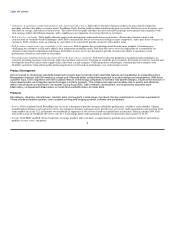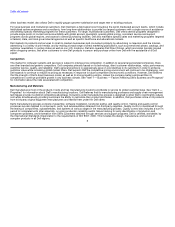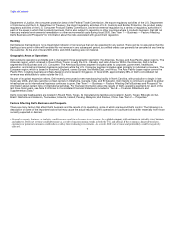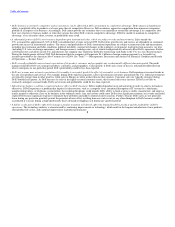Dell 2004 Annual Report Download - page 11
Download and view the complete annual report
Please find page 11 of the 2004 Dell annual report below. You can navigate through the pages in the report by either clicking on the pages listed below, or by using the keyword search tool below to find specific information within the annual report.
Table of Contents
• Dell's business is extremely competitive and no assurances can be offered that Dell can maintain its competitive advantage. Dell's success is based on its
ability to profitably offer its products at a lower price than its competitors. However, Dell encounters aggressive competition from numerous companies
globally in all aspects of its business. Accordingly, Dell cannot provide any assurance that it can maintain or extend this advantage if its competitors alter
their cost structure or business model, or take other actions that affect Dell's current competitive advantage. If Dell is unable to maintain its competitive
advantage, a loss of market share, revenue, or profitability may result.
• A substantial portion of Dell's net revenue is dependent upon international sales, which are subject to risks and uncertainties. Sales outside the
U.S. accounted for approximately 38% of Dell's consolidated net revenue in fiscal 2005. Dell's future growth rates and success are dependent on continued
growth and success in international markets. The success and profitability of Dell's international operations are subject to numerous risks and uncertainties,
including local economic and labor conditions, political instability, unexpected changes in the regulatory environment, trade protection measures, tax laws
(including U.S. taxes on foreign operations), and foreign currency exchange rates, any of which could potentially adversely affect Dell's operations. Further,
as Dell generates cash flows in non-U.S. jurisdictions, the company may experience difficulty transferring such funds to the U.S. in a tax efficient manner.
During the fourth quarter of fiscal 2005 Dell determined that the company will repatriate $4.1 billion in foreign earnings pursuant to a favorable tax
incentive provided by the American Jobs Creation Act of 2004. See "Item 7 — Management's Discussion and Analysis of Financial Condition and Results
of Operations — Income Taxes."
• Dell's overall profitability may not meet expectations if its product, customer, and geographic mix is substantially different than anticipated. The profit
margins realized by Dell vary among its products, customers, and geographies. Consequently, if Dell's mix of any of these is substantially different from
what it anticipates in any particular period, Dell's profitability could be less than expected.
• Dell's net revenue may not meet expectations if it is unable to accurately predict the effect of seasonality on its business. Dell experiences seasonal trends in
the sale of its products and services. For example, during Dell's third fiscal quarter, sales to government customers (particularly the U.S. federal government)
are typically stronger than in other quarters, while sales in Europe are often weaker than in other quarters. Consumer sales are typically strongest during
Dell's fourth fiscal quarter. As Dell increases its sales in the highly seasonal consumer sector, this seasonal effect may increase. If Dell is not able to
accurately anticipate seasonal trends, Dell's net revenue and profitability could be less than expected.
• Infrastructure failures could have a material adverse effect on Dell's business. Dell is highly dependent on its infrastructure in order to achieve its business
objectives. If Dell experiences a problem that impairs its infrastructure, such as a computer virus, intentional disruption of IT systems by a third-party,
manufacturing failure, or telephone system failure, the resulting disruptions could impede Dell's ability to book or process orders, manufacture, and ship in a
timely manner or otherwise carry on its business in the ordinary course. Any such events could cause Dell to lose significant customers or revenue and could
require Dell to incur significant expense to eliminate these problems and address related security concerns. Further, because Dell's sales are not generally
linear during any particular quarterly period, the potential adverse effect resulting from any such events or any other disruption to Dell's business could be
accentuated if it occurs during a disproportionately heavy demand or shipping cycle during any quarterly period.
• A failure on the part of Dell to effectively manage a product transition will directly affect the demand for Dell's products and the profitability of Dell's
operations. The technology industry is characterized by continuing improvements in technology, which result in the frequent introduction of new products,
short product life cycles, and continual improvement in product performance8


